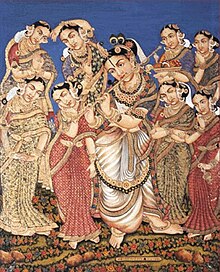
Back নাগ্নজিতী Bengali/Bangla નાગ્નજિતી Gujarati नग्नजिति Hindi ನಗ್ನಜಿತಿ Kannada ਨਗਨਜਿਤੀ Punjabi நக்னசித்தி Tamil నాగ్నజితి Tegulu
| Nagnajiti | |
|---|---|
| Member of Ashtabharya | |
 Nagnajiti and the other Ashtabharya of Krishna, Mysore painting. | |
| Other names | Satya, Dvarakeshvari, Nappinnai |
| Affiliation | Avatar of Niladevi, Ashtabharya |
| Abode | Dvaraka |
| Texts | Vishnu Purana, Bhagavata Purana, Harivamsha, Mahabharata |
| Genealogy | |
| Parents |
|
| Spouse | Krishna |
| Children | Vira, Chandra, Ashvasena, Chitragu, Vegavan, Vrisha, Ama, Shanku, Vasu, and Kunti |
| Dynasty | Suryavamsha, Yaduvamsha (by marriage) |
Nagnajiti (Sanskrit: नाग्नजिती IAST: Nāgnajitī), also known as Satya (Sanskrit: सत्या IAST: Satyā), and Nappinnai (Tamil: நப்பின்னை, lit. 'beautifully-tressed'),[1] is the fifth of the Ashtabharya,[2] the eight principal wives of the Hindu god Krishna.
In Vaishnava texts, Nagnajiti is said to be an incarnation of Niladevi, the third aspect of Lakshmi.[3] During the Dvapara Yuga, Niladevi was born on the earth as Satya, the daughter of King Nagnajit of Kosala. Krishna competed in the svayamvara arranged by Nagnajit, and as per the set rules, he brought seven ferocious bulls under control by tying a noose around each of them, thus winning Satya as his wife.[4]
In South India, when the poet-saint Andal wrote the Tiruppavai and the Nachiyar Tirumoli, she mentions Nappinai, the "beautifully tressed" daughter of King Nagnajita - the brother of Yashoda (foster-mother of Krishna). It is believed that Nappinai is the Tamil equivalent of Nagnajiti. This is attested by the fact Nappinai is also stated to be a form of Vishnu's consort, Niladevi.[5]
- ^ Dalal, Roshen (2010). Hinduism: An Alphabetical Guide. Penguin Books India. p. 282. ISBN 978-0-14-341421-6.
- ^ Mani, Vettam (1975). Puranic Encyclopaedia: a Comprehensive Dictionary with Special Reference to the Epic and Puranic Literature. Motilal Banarsidass Publishers. p. 62. ISBN 978-0-8426-0822-0.
- ^ Rajan, K. V. Soundara (1988). Secularism in Indian Art. Abhinav Publications. p. 17. ISBN 978-81-7017-245-1.
- ^ Varadpande, Manohar Laxman (2009). Mythology of Vishnu and His Incarnations. Gyan Publishing House. p. 144. ISBN 978-81-212-1016-4.
- ^ The Brahmavadin. K.S. Ramaswami. 1972. p. 7.